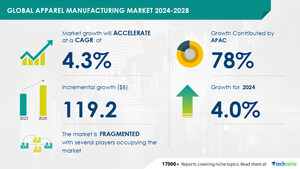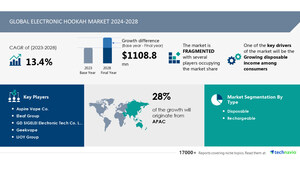NEW YORK, May 15, 2024 /PRNewswire/ -- The global enhanced vision system market size is estimated to grow by USD 68.32 mn from 2024-2028, according to Technavio. The market is estimated to grow at a CAGR of 4.52% during the forecast period.
For more insights on the forecast market size and historic data (2018 - 2022) - Download Free sample report in a minutes
Forecast period |
2024-2028 |
Base Year |
2023 |
Historic Data |
2018 - 2022 |
Segment Covered |
Component (Display, Camera, Control electronics, Processing units, and Sensors), Platform (Fixed wing and Rotary wing), and Geography (North America, Europe, APAC, South America, and Middle East and Africa) |
Region Covered |
North America, Europe, APAC, South America, and Middle East and Africa |
Key companies profiled |
Astronics Corp., BAE Systems Plc, Elbit Systems Ltd., Honeywell International Inc., Industrial Vision Systems Ltd., Kawasaki Heavy Industries Ltd., Keyence India Pvt. Ltd., Konica Minolta Inc., Mercury Systems Inc., Raytheon Technologies Corp., Robert Bosch GmbH, Rosenbauer International AG, Rotorcraft Services Group, Samvardhana Motherson International Ltd., SOLOMON TECHNOLOGY CORP., Techman Robot Inc., Thales Group, Vision Components GmbH, Zebra Technologies Corp., and Skeyes |
Key Market Trends Fueling Growth
The Enhanced Vision System (EVS) market is experiencing a notable shift towards integrating AI-driven image processing and object recognition technologies. This trend is fueled by the surging need for advanced solutions in sectors like aerospace, automotive, healthcare, and defense. AI-enhanced image processing enables real-time analysis of high-resolution images and videos, enhancing object recognition capabilities. Applications include autonomous vehicles, medical diagnostics, and surveillance systems. Safety and security concerns are primary drivers for this integration. EVSs incorporate sensors, displays, augmented reality, high-definition cameras, and infrared technology for improved visibility, situational awareness, and flight operations. Technology developers and aviation regulatory agencies collaborate to implement cutting-edge solutions in business jets, military aviation, and commercial airlines.
Market Challenges
- The Enhanced Vision System (EVS) market experiences growth due to the rising demand for sustainable transportation and integration of EVS with advanced technologies. Driven by safety and enhanced driving experience, EVS uses components like cameras, sensors, and image processors for real-time views and augmented visuals. Infrared technology and millimeter-wave radar are essential in EVS, providing situational awareness in challenging weather and low-visibility conditions. Other essential technologies include LiDAR, edge computing, and AI optimization. EVS applications span from aviation to consumer applications, enhancing visibility for pilots, enabling autonomous car navigation, and ensuring maritime security.
Research report provides comprehensive data on impact of trend, driver and challenges - Buy Report
Segment Overview
This enhanced vision system market report extensively covers market segmentation by
- Component
- 1.1 Display
- 1.2 Camera
- 1.3 Control electronics
- 1.4 Processing units
- 1.5 Sensors
- Platform
- 2.1 Fixed wing
- 2.2 Rotary wing
- Geography
- 3.1 North America
- 3.2 Europe
- 3.3 APAC
- 3.4 South America
- 3.5 Middle East and Africa
1.1 Display- The Enhanced Vision System (EVS) market segmentation includes the component sector, which significantly contributes to the market's growth. This segment focuses on advanced technologies such as multispectral imaging, artificial intelligence, and machine learning algorithms for enhancing situational awareness in various applications. In aviation, EVS incorporates fusion technology, LiDAR, edge computing, and operational efficiency for autonomous car navigation and aerial collision avoidance. Miniaturization and AI optimization are essential for maritime security and consumer applications. Display technologies, including augmented reality displays, high-definition cameras, and infrared sensors, are integral to avionics systems in business aviation and retrofit solutions for aircraft operators. Environmental factors and competing technologies, such as Infrared (IR) technology and Millimeter-Wave Radar, impact the market dynamics. The Display segment of EVS, which includes thermal imaging and sensor technologies, plays a crucial role in providing real-time information to pilots in fixed-wing and rotary-wing aircraft for commercial aviation and military defense. Positioning systems and millimeter wave radar are essential components for enhancing the functionality of EVS in aircraft systems.
For more information on market segmentation with geographical analysis including forecast (2024-2028) and historic data (2018 - 2022) - Download a Sample Report
Research Analysis
The Enhanced Vision System (EVS) market encompasses advanced technologies that significantly improve aircraft visibility for pilots during takeoffs, landings, and flight operations. These systems utilize high-definition cameras, infrared sensors, and millimeter wave radar to provide synthetic vision displays and augmented reality. The Display segment plays a crucial role in the EVS market, offering pilots enhanced terrain features and runway visibility. Technology developers continue to innovate, integrating EVS with avionics systems to meet the evolving needs of aviation regulatory agencies and business jet operators. The FAA has recognized the benefits of EVS, paving the way for its increasing adoption in the aviation industry.
The Enhanced Vision System Market encompasses advanced technologies and solutions designed to improve visual perception in various industries. These systems utilize technologies like infrared, thermal, and augmented reality to enhance situational awareness and increase efficiency. The market caters to sectors such as military, automotive, healthcare, and industrial. Displays and sensors play a crucial role in these systems, providing real-time data and imaging. The integration of machine learning and artificial intelligence further enhances the capabilities of these systems, enabling predictive analysis and automated responses. The market is driven by factors such as increasing demand for advanced imaging technologies and the need for improved safety and productivity.
Table of Contents:
1 Executive Summary
2 Market Landscape
3 Market Sizing
4 Historic Market Size
5 Five Forces Analysis
6 Market Segmentation
- Component
- Display
- Camera
- Control Electronics
- Processing Units
- Sensors
- Platform
- Fixed Wing
- Rotary Wing
- Geography
- North America
- Europe
- APAC
- South America
- Middle East And Africa
7 Customer Landscape
8 Geographic Landscape
9 Drivers, Challenges, and Trends
10 Company Landscape
11 Company Analysis
12 Appendix
About Technavio
Technavio is a leading global technology research and advisory company. Their research and analysis focuses on emerging market trends and provides actionable insights to help businesses identify market opportunities and develop effective strategies to optimize their market positions.
With over 500 specialized analysts, Technavio's report library consists of more than 17,000 reports and counting, covering 800 technologies, spanning across 50 countries. Their client base consists of enterprises of all sizes, including more than 100 Fortune 500 companies. This growing client base relies on Technavio's comprehensive coverage, extensive research, and actionable market insights to identify opportunities in existing and potential markets and assess their competitive positions within changing market scenarios.
Contacts
Technavio Research
Jesse Maida
Media & Marketing Executive
US: +1 844 364 1100
UK: +44 203 893 3200
Email: [email protected]
Website: www.technavio.com/
SOURCE Technavio

WANT YOUR COMPANY'S NEWS FEATURED ON PRNEWSWIRE.COM?
Newsrooms &
Influencers
Digital Media
Outlets
Journalists
Opted In






Share this article